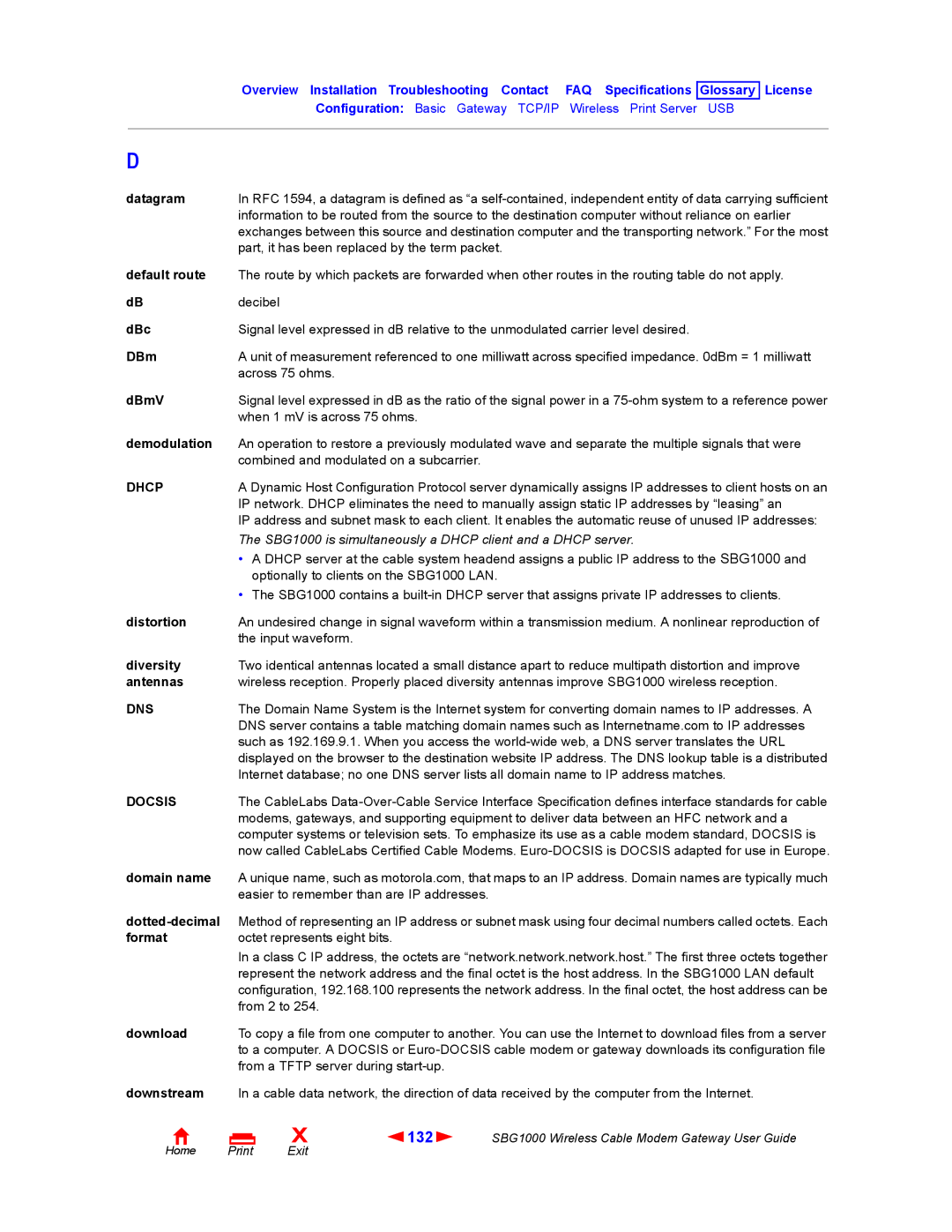
Overview Installation Troubleshooting Contact | FAQ Specifications | Glossary | License |
Configuration: Basic Gateway TCP/IP | Wireless Print Server | USB | |
|
|
|
|
D
datagram | In RFC 1594, a datagram is defined as “a |
| information to be routed from the source to the destination computer without reliance on earlier |
| exchanges between this source and destination computer and the transporting network.” For the most |
| part, it has been replaced by the term packet. |
default route | The route by which packets are forwarded when other routes in the routing table do not apply. |
dB | decibel |
dBc | Signal level expressed in dB relative to the unmodulated carrier level desired. |
DBm | A unit of measurement referenced to one milliwatt across specified impedance. 0dBm = 1 milliwatt |
| across 75 ohms. |
dBmV | Signal level expressed in dB as the ratio of the signal power in a |
| when 1 mV is across 75 ohms. |
demodulation | An operation to restore a previously modulated wave and separate the multiple signals that were |
| combined and modulated on a subcarrier. |
DHCP | A Dynamic Host Configuration Protocol server dynamically assigns IP addresses to client hosts on an |
| IP network. DHCP eliminates the need to manually assign static IP addresses by “leasing” an |
| IP address and subnet mask to each client. It enables the automatic reuse of unused IP addresses: |
| The SBG1000 is simultaneously a DHCP client and a DHCP server. |
| • A DHCP server at the cable system headend assigns a public IP address to the SBG1000 and |
| optionally to clients on the SBG1000 LAN. |
| • The SBG1000 contains a |
distortion | An undesired change in signal waveform within a transmission medium. A nonlinear reproduction of |
| the input waveform. |
diversity | Two identical antennas located a small distance apart to reduce multipath distortion and improve |
antennas | wireless reception. Properly placed diversity antennas improve SBG1000 wireless reception. |
DNS | The Domain Name System is the Internet system for converting domain names to IP addresses. A |
| DNS server contains a table matching domain names such as Internetname.com to IP addresses |
| such as 192.169.9.1. When you access the |
| displayed on the browser to the destination website IP address. The DNS lookup table is a distributed |
| Internet database; no one DNS server lists all domain name to IP address matches. |
DOCSIS | The CableLabs |
| modems, gateways, and supporting equipment to deliver data between an HFC network and a |
| computer systems or television sets. To emphasize its use as a cable modem standard, DOCSIS is |
| now called CableLabs Certified Cable Modems. |
domain name | A unique name, such as motorola.com, that maps to an IP address. Domain names are typically much |
| easier to remember than are IP addresses. |
| Method of representing an IP address or subnet mask using four decimal numbers called octets. Each |
format | octet represents eight bits. |
| In a class C IP address, the octets are “network.network.network.host.” The first three octets together |
| represent the network address and the final octet is the host address. In the SBG1000 LAN default |
| configuration, 192.168.100 represents the network address. In the final octet, the host address can be |
| from 2 to 254. |
download | To copy a file from one computer to another. You can use the Internet to download files from a server |
| to a computer. A DOCSIS or |
| from a TFTP server during |
downstream | In a cable data network, the direction of data received by the computer from the Internet. |
Home Print
X | 132 | SBG1000 Wireless Cable Modem Gateway User Guide |
Exit |
|
|
